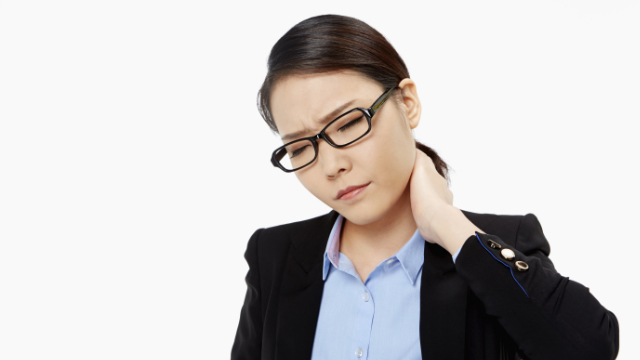
There’s a good reason that we often call things that bother us a “pain in the neck.” Neck pain is one of the most common health problems in the world, and it’s second only to back pain in terms of painful muscle and bone disorders. Statistics vary on just how prevalent neck pain is, but some figures estimate that as many as 80% of Americans experience it at least once each year. Depending on your age, there are different types of problems that can affect the neck, but the result is usually the same: neck pain and discomfort that gets in the way of normal movement.
The skeletal part of your neck is called the cervical spine, which is made up of seven bones (vertebrae). The vertebrae are referred to as C1-C7—the “C” stands for cervical—starting at the base of the skull (C1) and counting up towards the chest area (C7). Between each vertebra is an intervertebral disc, which cushions the bones and serves as a shock absorber. We use our cervical spine every time we nod, turn, or rotate our head in any direction, and this wide range of motion is one of the main reasons neck pain is so common.
For children and young adults, neck pain is far less common than it is later in life, but there are still plenty of issues that can occur. In this age group, most neck problems are due to strains and sprains of the muscles and ligaments in the neck. Here’s what usually happens:
- Neck muscles and ligaments are flexible, but sometimes they can be pushed too far
- This often occurs from holding bad postures—like staring down at a computer or cellphone—for extended periods of time, or sleeping on the neck wrong
- Symptoms include pain and discomfort in the back, side, or front of the neck that limits movement and activity
As we get older, neck strains and sprains remain common, but a number of other neck-related conditions are also more likely to start developing. In the course of the normal aging process, several age-related changes begin to occur in certain parts of the cervical spine. What generally tends to happen is that the structures that make up the neck become weaker, the intervertebral discs lose some of their height, and the joints in the neck adapt to other changes in the body. Eventually, these changes make the structures of the neck slightly less effective, and as a result:
- Osteoarthritis may develop, which occurs from losing some of the protective cartilage that surrounds the ends of bones
- Spondylosis is another general term used to describe any pain related to age-related changes in the spine; this also becomes more common with aging
- Problems with the intervertebral discs can lead to a herniated, or “slipped” disc, which may cause pain and other symptoms that radiate through the arms
These types of issues typically tend to develop between ages 40-60, but can be seen even earlier in certain individuals. Symptoms also range significantly, as some people experience regular pain and physical limitations, while others don’t notice any symptoms, even though these age-related changes are still occurring.
For adults over the age of 65, age-related changes continue to occur and may begin to become more advanced in some cases. This means that conditions like osteoarthritis and spondylosis are even more likely at this age, and they can be more severe for some individuals. Other conditions like spinal stenosis and osteoporosis also become more common in older age and add to the list of possible neck problems. Spinal stenosis is a narrowing of the spinal canal that puts pressure on the structures within it, while osteoporosis is a condition that causes bones to become weak and brittle. Other mobility limitations could make neck-related issues even more of an impairment for the elderly, but all of these problems are still treatable.
What’s important to understand is that while there is nothing that can be done to stop the aging process, there are countless changes you can make to your everyday life that can significantly reduce your chances of experiencing neck pain at any stage of life.
